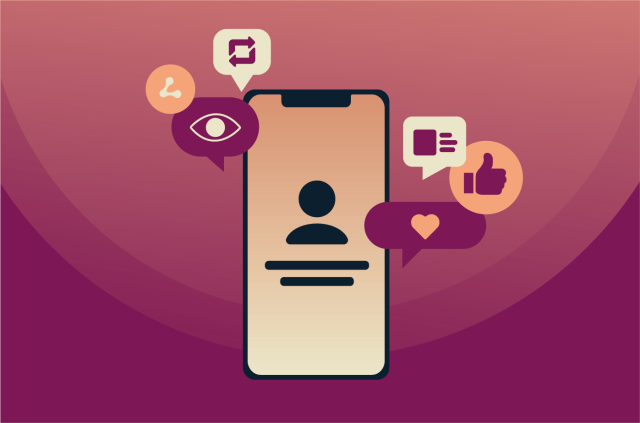2023 Misinformation Index: Top celebrities unwittingly associated with fake news


- Elon Musk tops the 2023 Misinformation Index with 157,385 engagements, showcasing his prominent role in both tech and media, which makes him a frequent target of fake news.
. - Soccer players Lionel Messi and Neymar Jr. feature prominently in the fake news sphere, with stories about their transfers generating significant public attention and misinformation.
.
- Rihanna and Meghan Markle faced false rumors about their pregnancies, demonstrating how personal aspects of celebrities' lives are often subjects of fabricated news.
.
- Advanced technology like AI and deepfakes are increasingly used to create and spread false stories about celebrities, with Taylor Swift and BTS being prime examples.
.
- You can protect yourself from fake news by evaluating news sources, cross-checking information, and using tools like a VPN download to access diverse information sources by breaking through censorship.
Fake news doesn't spare the famous. This year, ExpressVPN's 2023 Misinformation Index reveals a surprising lineup of celebrities, from BTS and Taylor Swift to Lionel Messi, caught in the crossfire of fabricated stories. Our analysis, powered by Buzzsumo's social media insights, uncovers how these high-profile individuals become the unintended faces of false narratives.
Through this report, we delve into the mechanics of misinformation, examining how celebrities inadvertently become linked to fake news. From AI-generated illusions to outlandish rumors about their lives, we shed light on the nature and impact of these falsehoods. Join us as we unravel the complex web of 2023's celebrity fake news, separating fact from fiction in the world of fame and influence.
Jump to….
- Is all fake news bad?
- Top 20 celebrities associated with fake news
- Where politicians rank in the fake news arena
- How to protect yourself from problematic fake news
- Top signs a news story is fake
- Methodology
Is all fake news bad?
When we hear “fake news,” our minds often jump to misinformation with harmful intentions. But before we dive into our index, it’s important to note that not all fake news is created equal. To understand its impact, it's essential to first grasp what fake news really is, when it's not necessarily bad, and when it becomes a problem.
What is fake news?
At its core, fake news is information that's been fabricated and presented as legitimate news. It's designed to look and feel like real news, but its facts are either twisted or completely made up. The rise of social media has turbocharged the spread of fake news, making it a significant challenge in today’s society.
When fake news isn’t necessarily a bad thing
Sometimes, what's labeled as fake news isn't inherently harmful. For example:
- Satire and parody: Many satirical news outlets like The Onion deliberately produce exaggerated or fictitious stories to highlight absurdities or critique societal issues. While technically “fake,” these stories are meant to entertain and provoke thought rather than deceive.
- Mistakes and errors: Journalists and news outlets can make mistakes, but this doesn't always mean there's an intent to mislead. Media outlets also have biases, which doesn’t necessarily mean something is fake news—but it depends on the degree to which something is misrepresented.
When fake news is problematic
Fake news becomes a serious issue when it's used to misinform or manipulate. For instance:
- Spreading misinformation: Deliberately false stories can mislead people, especially when they confirm existing biases or fears. This can affect public opinion and even influence important decisions, like voting.
- Damaging reputations: Fake news can unjustly harm the reputation of individuals or organizations, leading to real-world consequences like loss of trust, harassment, or financial damage.
The danger of engaging with problematic fake news
Every time a potentially damaging fake news story is liked, shared, or commented on, it amplifies the story's reach. This means that a larger audience gets exposed to the misinformation.
In fact, for every engagement on a fake news story, it's estimated that an additional 100 people are exposed to that story. This exponential increase in exposure can rapidly turn a single piece of misinformation into a widely accepted narrative. This can inadvertently deepen societal divides, fueling conflicts and misunderstandings within communities.
Top 20 celebrities associated with fake news in 2023
The link between fame and fake news is almost inevitable. High-profile individuals, especially celebrities, are constantly in the public eye, making them ripe targets for fake news. Their wide reach and influence mean that any story associated with them, true or false, has the potential to go viral. This high visibility, coupled with the public's insatiable curiosity about their lives, creates a fertile ground for the spread of misinformation.
Moreover, celebrities often represent ideals, lifestyles, and opinions that can be polarizing, making them easy targets for fake stories that aim to confirm biases or stir controversy. In some cases, fake news about celebrities is used to divert attention or to push a certain agenda, leveraging their fame to gain traction.
Using Buzzsumo’s social listening tool, we identify which celebrities, politicians, and other public figures were most frequently mentioned alongside the term “fake news” over the past year. Our investigation includes the engagement the articles and posts received—which encompasses likes, comments, and shares.
Here are some of our key findings:
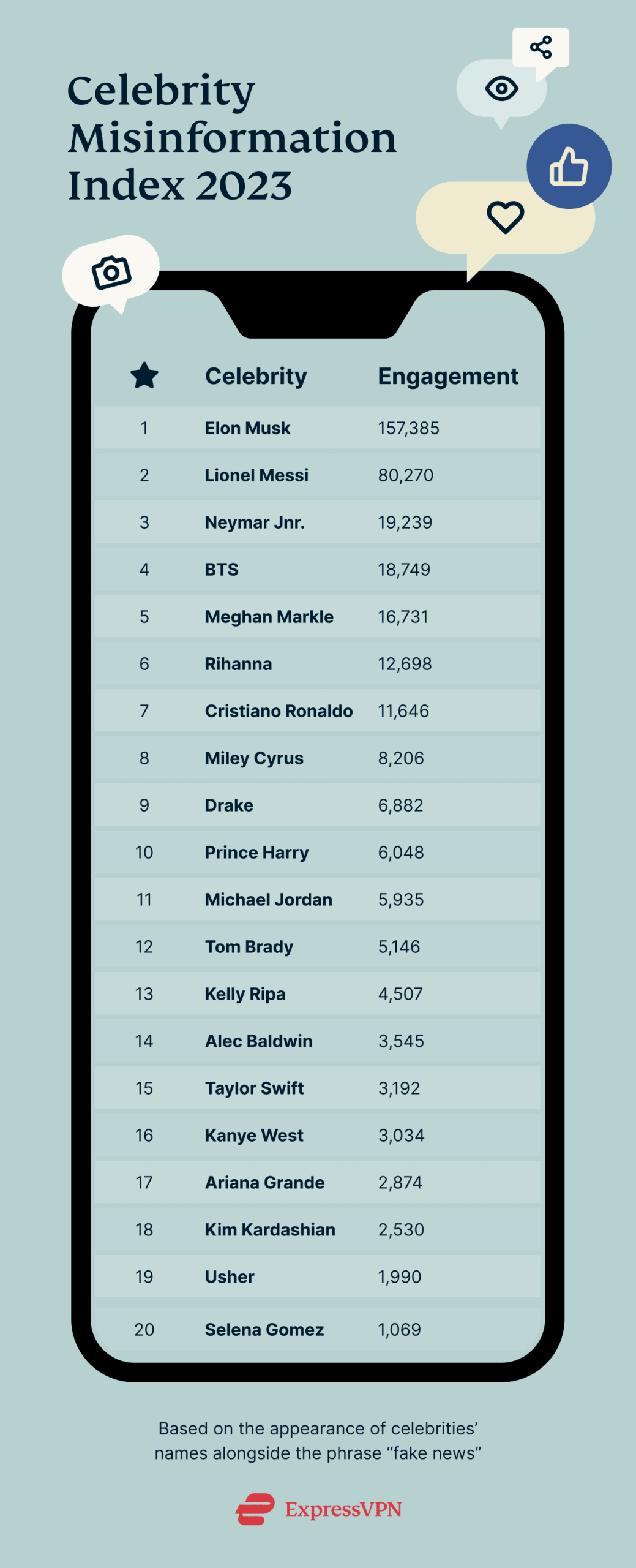
Musk at the center of fake news storm
Elon Musk, who dominated headlines this year thanks to his social media platform X, tops our 2023 fake news index with 157,385 engagements. These posts associated with him, potentially reaching over 15 million people, show how Musk's public role in technology and media makes him a prime figure for controversy.
Musk's leadership at X puts him in the thick of the fight against misinformation. However, his platform has been criticized for spreading false information, drawing concern from groups like the European Union. Musk himself has been caught up in fake news controversies. For example, he shared a link from a questionable source, leading to a dispute with The New York Times. When the Times covered this, Musk hit back, calling them fake news.
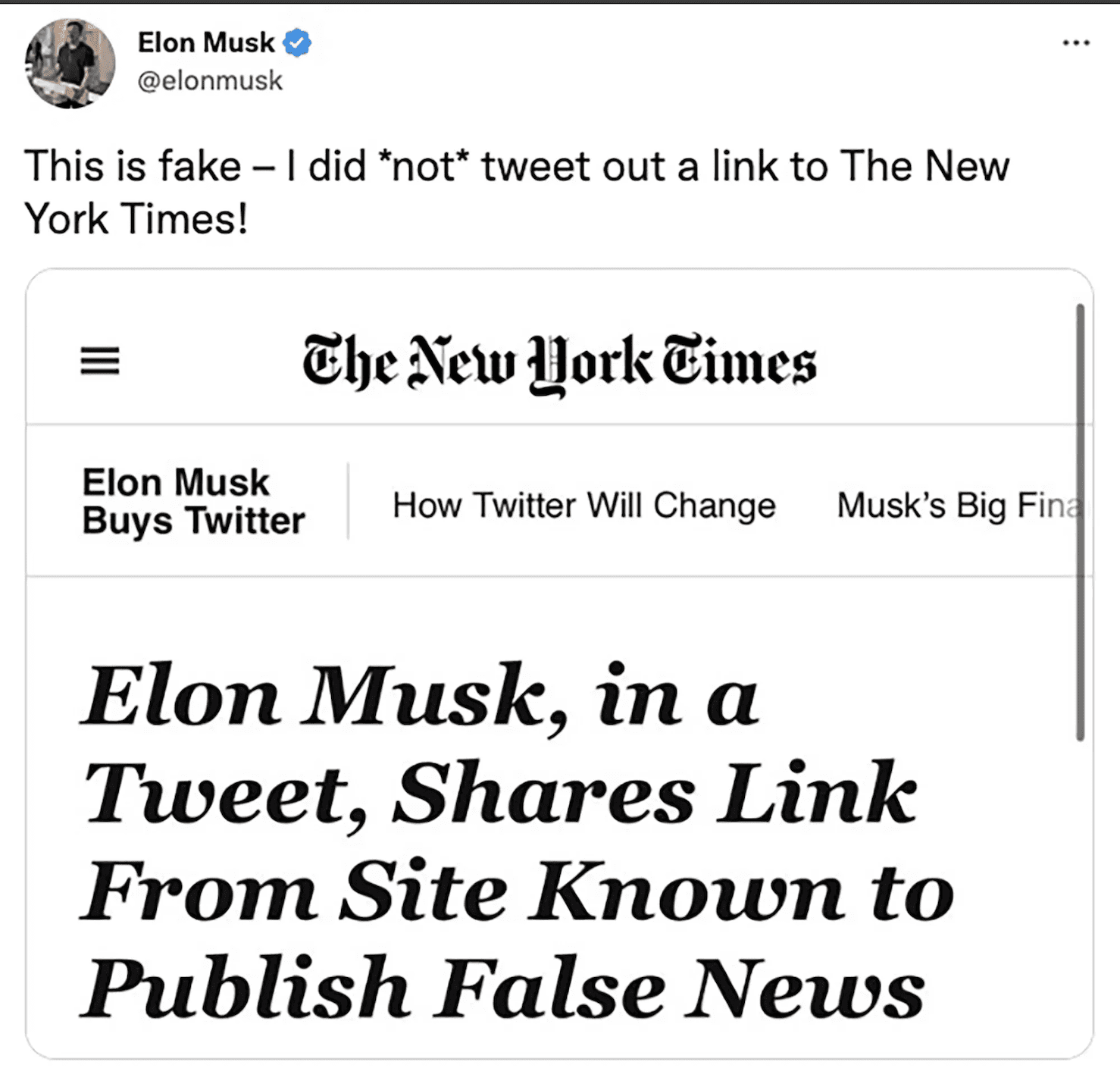
Ironically, Musk is often the subject of the very fake news he aims to combat. Notable examples include rumors about his death and a doctored video claiming he introduced a quantum AI project to eradicate poverty. The video, mimicking a segment from Fox News' former show Tucker Carlson Tonight, showed Carlson introducing Musk and this supposed project. But it was all fake—the audio didn't match the video, and Fox News confirmed it was doctored.
Soccer stars caught in fake transfer news net
Athletes aren’t immune to fake news controversies, as seen in recent stories about Lionel Messi, Neymar, and Cristiano Ronaldo. These stories, often about their transfers to new teams, highlight the issue of misinformation in sports media.
Messi was at the center of various false stories, with over 80,270 people engaging with fake news mentions alongside the star’s name. While Paris Saint-Germain (PSG) was discussing a new contract with him earlier this year, rumors flew about a dramatic return to Barcelona. Then came whispers of a massive 400 million USD annual deal with Saudi Arabia’s Al-Hilal. In reality, Messi joined David Beckham’s Inter Miami in Major League Soccer (MLS), earning 20.4 million USD, throwing fans and bookies off with the unexpected move.
Neymar's potential move from PSG in August sparked a wave of fake news, adding drama to the transfer window. When rumors emerged about him transferring to Al-Hilal in Saudi Arabia, similar to Cristiano Ronaldo's move to Al-Nassr, speculation ran rampant. Amidst these discussions, a piece of false information spread in the Brazilian media, claiming Neymar was released from PSG due to poor physical form. Neymar himself came forward to deny these rumors.
Cristiano Ronaldo's move to Al Nassr had its share of fake news, too. Altered photos and false reports flooded the internet, including one that falsely claimed he married his girlfriend in Saudi Arabia. Another rumor from January 2023 suggested he threatened to leave the Portugal national team after the 2022 World Cup. These claims were debunked by the Portuguese Football Federation.
Fake baby news boomed
Rihanna and Meghan Markle found themselves at the center of fake baby news this year, resulting in them claiming the 5th and 6th spots on our index, respectively. A deepfake video falsely showing Rihanna pregnant with her third child caused quite a stir. Despite giving birth to her second child with A$AP Rocky in August 2023, a subsequent rumor about her expecting another baby soon after quickly spread during Veterans Day weekend, but it was completely untrue.
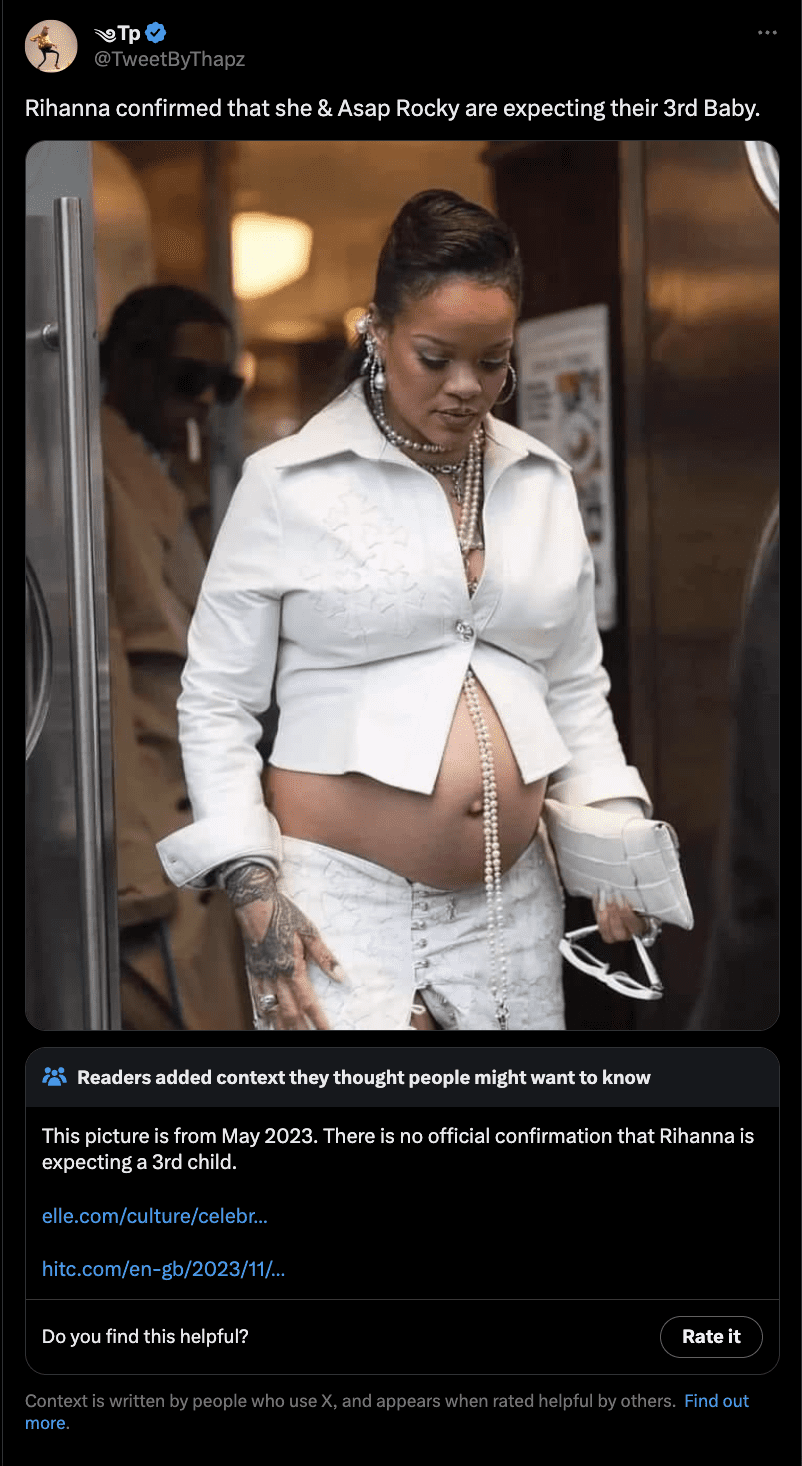
Meghan Markle faced similar false claims in December 2022. Conspiracy theorists wrongly asserted that her pregnancy was fake and that a surrogate carried her and Prince Harry’s two children. These theories were debunked by several fact-checking sources. Adding to the controversy, in the same month, Meghan's sister Samantha Markle criticized the Suits actress’ new Netflix docuseries, labeling it a “100 million USD fake news PR machine.”
Prince Harry is also no stranger to being the subject of fake news. His name generated 6,048 engagements on fabricated news stories, following the release of his explosive biography, Spare. One such rumor circulating was that the British royal was considering getting into American politics.
AI is fuelling fake news stories
The rise of AI, particularly deepfake technology, is reshaping the landscape of fake news, especially around celebrities like Taylor Swift, Selena Gomez, and BTS. Deepfakes are sophisticated AI creations that make it look like real people are doing or saying things they never did. This tech is now a major tool for spreading fake stories about famous people.
A shocking example was the story of Saint Von Colucci, a supposed actor and singer who reportedly died after he underwent multiple surgeries to look like Jimin from BTS. Media worldwide buzzed with reports of his alleged passing, his 200,000 USD surgeries, and his role in a Korean drama. But Von Colucci never existed. Evidence suggests he's an AI-generated hoax that managed to trick the global media.
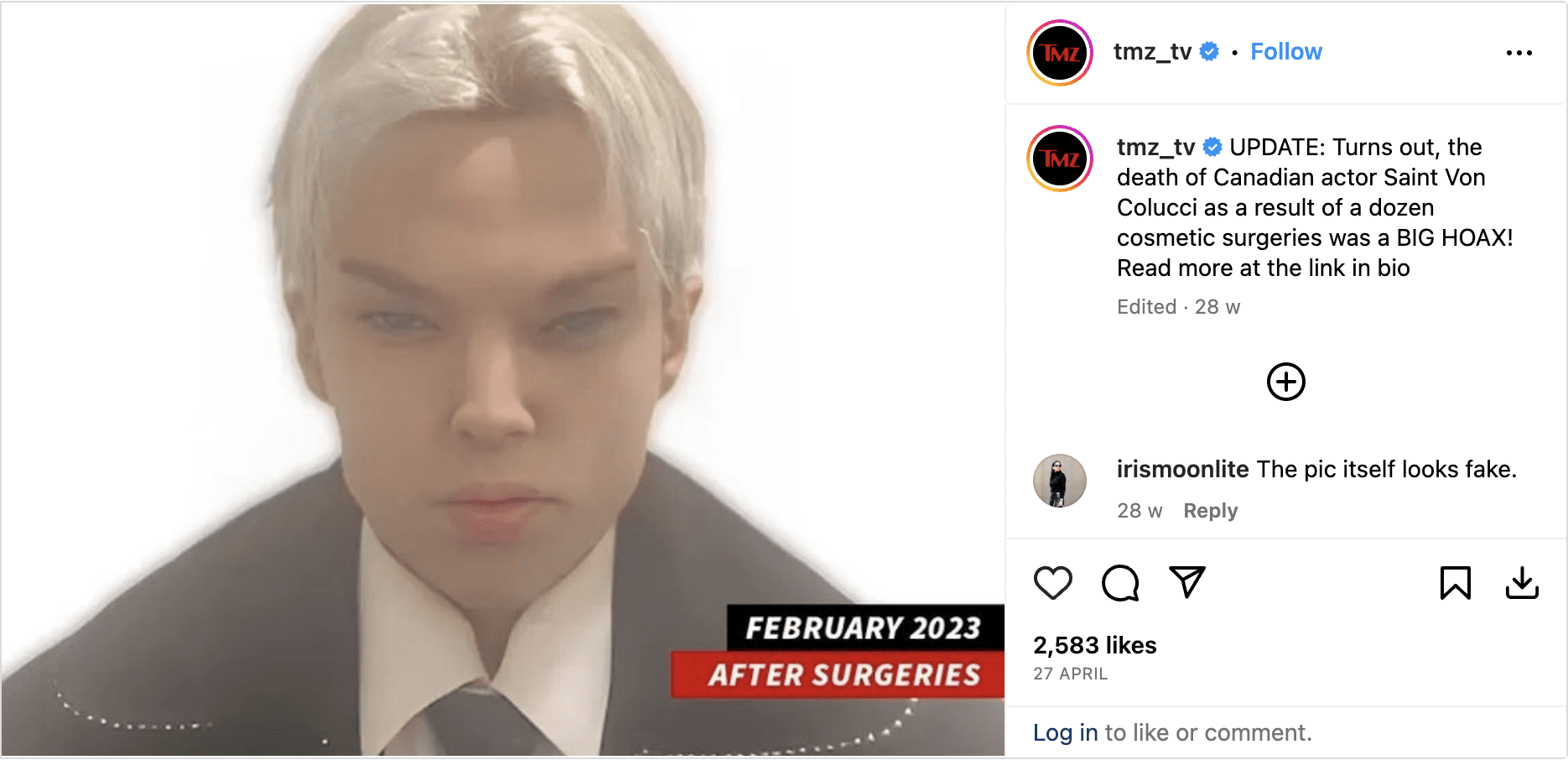
Taylor Swift faced a similar issue with a racially charged fake story and image circulating on Reddit, showing her eating ice cream in front of hungry children. The image was made using AI, and the story was completely fabricated, including the claim that it was part of her Eras tour—which never had an African leg. Swift's global fame and the public's interest in her personal life, like her new relationship with Travis Kelce, make her an ideal target for such misinformation.

Selena Gomez was another victim, with a fake photo claiming to be taken at this year’s Met Gala. Her image was superimposed onto actress Lily James from the previous year. Fans or pranksters often create false images of their favorite stars for various reasons, like seeking attention, generating clicks, or even just for entertainment.
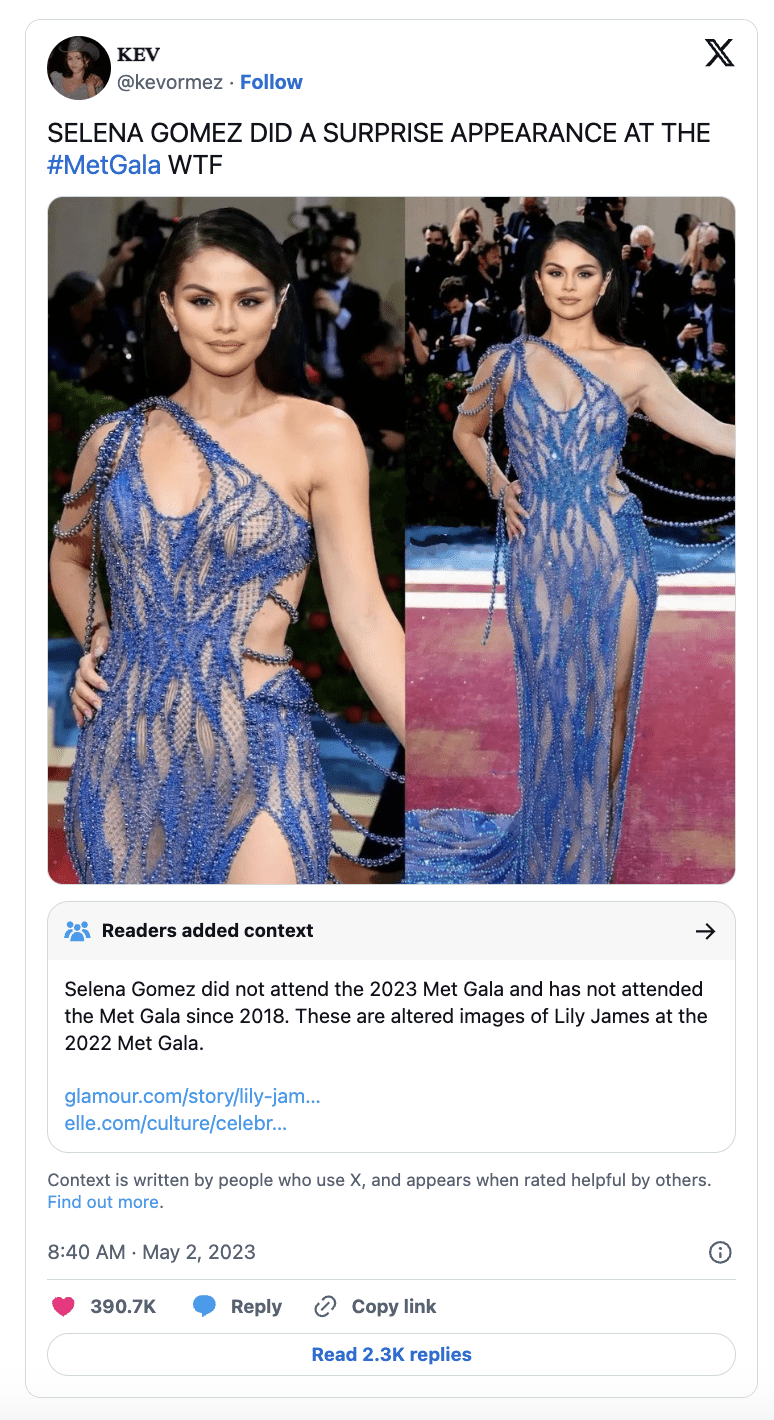
These cases show how deepfakes and AI manipulations are being used to mislead and manipulate public opinion, damaging the reputations of celebrities. The ease of creating and spreading these fakes, coupled with the viral nature of celebrity news, poses a serious challenge. It's getting harder to tell real from fake, threatening the trust in information we see online.
Where politicians rank in the fake news arena
Donald Trump and Joe Biden, key figures in the upcoming 2024 U.S. presidential elections, are often targets of fake news. Trump, with 28,386 engagements, frequently labels unfavorable reports as fake news, a stance amplified by his recent legal issues and election activities. Biden, with 10,662 engagements, has also faced false stories, including claims of impeachment in June 2023. Russian President Vladimir Putin is also mentioned, notably in relation to the ongoing conflict in Ukraine.
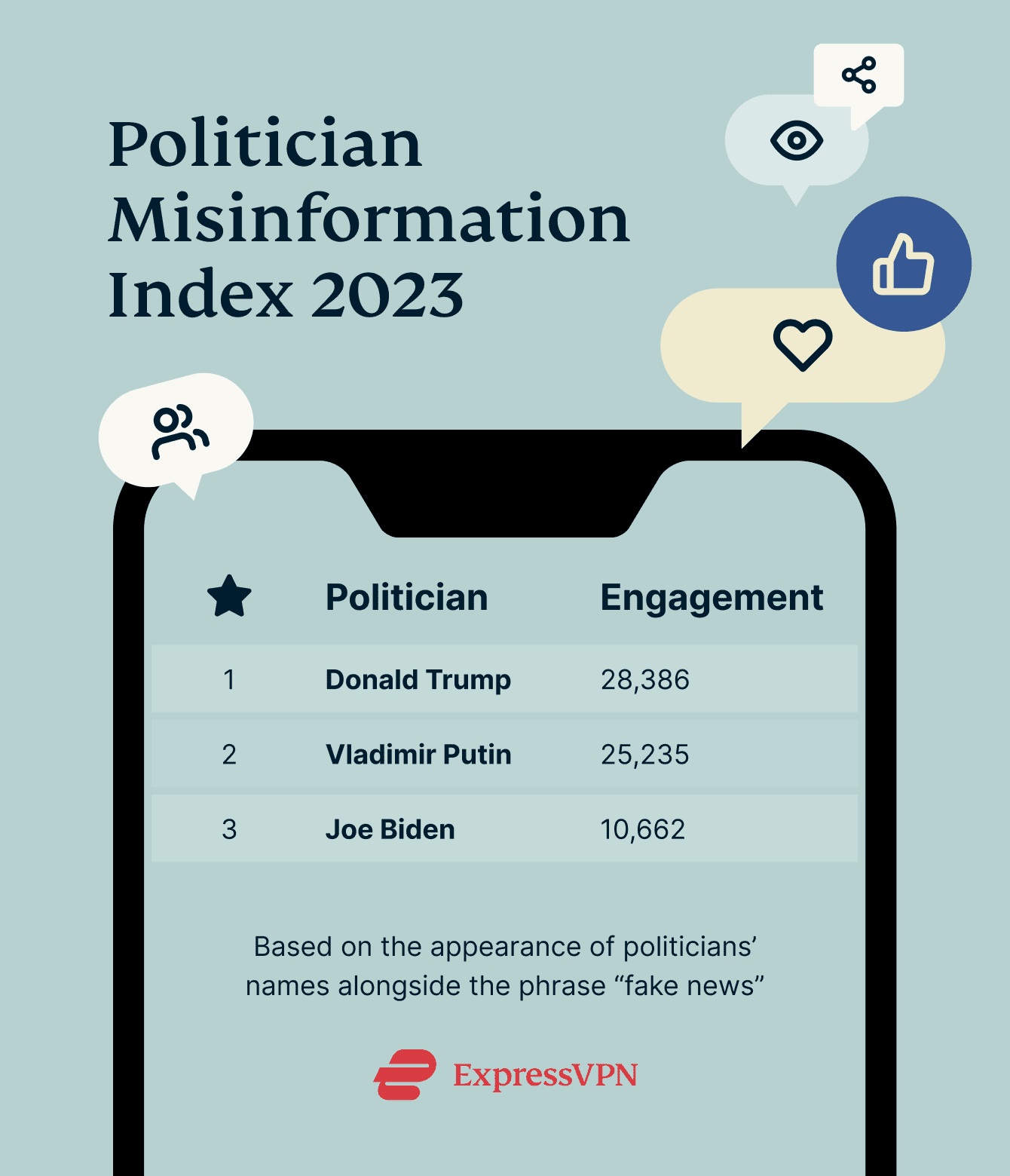
Fake news about politicians is often created to influence public opinion or to sway political discourse. It's a tool used to manipulate perceptions, rally support, or discredit opponents, reflecting the power of misinformation in shaping political landscapes. This trend highlights the need for vigilant information consumption, especially regarding political figures and events.
How to protect yourself from problematic fake news
As AI deepfakes and other technology continue to advance, it's important to approach every extreme news story with caution. To avoid falling victim to fake news stories and believing misinformation, here are some practical steps you can take:
- Evaluate every news source: Always question the credibility of the source and the evidence supporting the story.
- Cross-check with other sources: Verify the news by checking multiple reputable media platforms.
- Use fact-checking websites: These sites can help confirm the authenticity of news stories.
- Be cautious of sensational headlines: Dramatic or unbelievable headlines may not accurately represent the content.
- Educate yourself about deepfakes: Knowing about deepfakes, and looking out for the signs of one, can help you assess the authenticity of videos and images.
- Download a VPN for diverse information: A VPN download allows you to access a wide range of news sources, particularly in areas with restricted internet, helping you break through censorship so that you can better spot fake news.
- Check the date and context of news stories: Ensure the story is recent and relevant.
- Be skeptical of news on social media: Always verify news from social media with credible sources.
- Err on the side of caution when it comes to sharing: Think twice before spreading information that is extreme or seems sensationalist.
- Learn how to spot the red flags that a news story is fake: Recognizing these signs can help you identify and avoid misinformation (more on this below).
10 signs a new story is fake
Here are some indicators to help you discern whether a news story might not be genuine:
- Unreliable source: If the story comes from a website known for sensationalism or one that isn't recognized for journalistic integrity, it's a red flag. For example, a site that frequently posts rumors or conspiracy theories is likely not a reliable source.
- Lack of evidence: Genuine news stories are typically backed by verifiable facts or sources. If an article makes bold claims without any supporting evidence, such as official statements, expert opinions, or credible data, it could be fake.
- Sensational headlines: Headlines that seem overly dramatic or implausible might be designed to attract clicks rather than report facts. For instance, a headline claiming a celebrity did something outrageous without any credible source is likely sensationalized.
- Inconsistencies in the story: If the narrative of the story contradicts itself or well-established facts, it's a sign of unreliability. An example would be a story about a public event that differs significantly from reports by multiple reputable news outlets.
- Poorly written content: Professional news articles are generally free from significant spelling and grammatical errors. A poorly written article might indicate low editorial standards, often seen in hastily produced fake news.
- Altered images or videos: Fake news often uses edited images or videos taken out of context. Tools, like reverse image search, can help check if the media in the story has been altered or used in misleading ways.
- No coverage by other outlets: If a supposedly major story isn't covered by any other reputable news outlet, it's likely not true. Real news, especially significant events, is usually reported by multiple sources.
- Biased tone: While some level of bias can be present in all reporting, a heavily biased tone that seems to push an agenda rather than provide balanced information can indicate a fake story.
- Excessive requests for shares or clicks: Authentic news content doesn't typically beg for shares or clicks. If an article focuses more on this than delivering news, it's likely not legitimate.
- Emotionally charged content: News aiming to inform tends to avoid evoking strong emotional reactions. If a story seems designed to make you angry or afraid, it might be fake, intended more to manipulate emotions than to inform.
Methodology
To find out which celebrities are most linked to fake news, we first determined the most searched-for celebrities online. Using social listening tools, we then counted how often their names came up with the term “fake news” on social media, forums, and comments from November 2022 to November 2023.
We looked at how people interacted with these posts—for example, likes, comments, and shares. This helped us see not just who was mentioned, but how much attention the posts got. We estimate that the potential reach of these posts could be up to 20 times the actual engagements.
Based on this, we ranked the celebrities by how much engagement the fake news stories about them received. This tells us who got the most attention in fake news.
FAQ: About celebrity fake news
What are the effects of fake news?
- Misleading the public: Fake news can spread misinformation, leading to widespread misunderstandings and misconceptions.
- Reputational damage: Individuals, especially public figures, can suffer significant harm to their reputation due to false stories.
- Influencing public opinion and behavior: Fake news can shape public opinion and even influence important decisions, such as voting in elections.
- Exacerbating social and political divides: By playing into existing biases, fake news can deepen societal and political divisions.
- Undermining trust in media: Persistent fake news erodes public trust in legitimate news sources, complicating efforts to stay informed.
- Real-world consequences: In some cases, fake news has led to real-world actions, including violence or public health challenges.
What are some fake news websites?
- The National Report: Known for publishing false stories and hoaxes, often mimicking the style of legitimate news outlets.
- Infowars: A site that has been widely criticized for promoting conspiracy theories and misinformation.
- The Onion: A well-known satirical website that publishes humorous and exaggerated articles, meant for entertainment rather than deception.
- The Babylon Bee: Similar to The Onion, it's a satirical site that creates fictitious stories, primarily for comedic effect.
It's important to note that satire, like that from The Onion and The Babylon Bee, serves a different purpose than deliberately misleading fake news. Satirical sites intend to entertain and often provide social commentary, whereas sites like The National Report or Infowars may spread misinformation for other motives. Understanding the intent and context behind these websites is key to distinguishing harmful fake news from satire.
How does fake news spread?
- Social media platforms: The rapid sharing capabilities of social media enable fake news to reach large audiences quickly.
- Online communities and forums: Certain online groups or forums can be echo chambers for fake news, where unverified information circulates without scrutiny.
- Messaging apps: Encrypted or private messaging apps can also be hotbeds for the spread of fake news, often beyond the reach of fact-checkers or content moderators.
- Word of mouth: Sometimes, fake news is spread through personal networks, where individuals share information with friends and family.
- Sensationalism: Content that evokes strong emotions or confirms pre-existing beliefs is more likely to be shared, aiding the spread of fake news.
Take the first step to protect yourself online. Try ExpressVPN risk-free.
Get ExpressVPN
